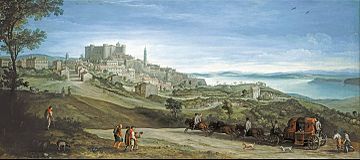保罗·布利尔Bril, Paul
保罗·布利尔Bril, Paul(1554年—1626年10月7日),意大利画家。
生活
多山的地形与圣杰罗姆,1592年
保罗成Bril被认为是出生在安特卫普尽管他出生的地方布雷达。他是画家Matthijs成Bril老的儿子。保罗和他的哥哥Matthijs可能开始自己的艺术训练和他们的父亲在安特卫普。保罗也可能是一个学生的安特卫普画家Damiaen Wortelmans专攻羽管键琴的摆设。
Matthijs搬到罗马可能1575左右。在这里他在几个工作壁画在梵蒂冈宫。人们相信保罗在罗马周围或加入他的兄弟在1582年之后。
Matthijs于1583年去世时,他的弟弟可能继续他的工作,拿起许多Matthijs的佣金。保罗的最早日期从1580年代后期工作。他建立了他的声誉与佣金从教皇Gregorius十三世Collegio Romano。他的成功后向教皇西克斯V成为他的主要赞助者。成Bril是一个团队的一部分专业山水画,因此参加了几乎所有的作业这导致装饰景观,如在圣玛利亚教堂马焦雷,梵蒂冈宫的Scala圣诞老人.另一个重要的早期委员会是壁画的循环圣塞西莉亚Trastevere在罗马的1599左右。
戴安娜和木卫四,可能是1620年代
教皇克莱门特八世也成为他的赞助人,给艺术家一个委员会的海景的殉难圣克莱门特。保罗成Bril完成这个委员会在梵蒂冈宫的萨拉克莱门蒂娜合作的兄弟乔凡尼和Cherubino尔贝蒂(1600 - 02/3)。1601年保罗收到了另一个主要委员会,油漆的一系列大型画布的属性加尼姆的家人.[2]保罗进一步画壁画的赌场戴尔'Aurora宫殿Pallavicini-Rospigliosi在罗马。
他的顾客中最具影响力的人在罗马和包含成员报摊,鲍格才家族加尼姆,Barberini家庭在罗马红衣主教费德里科•包罗密在米兰,红衣主教卡洛·德·美第奇在弗洛伦斯和杜克费迪南贡扎加在曼图亚.
1621年,保罗成Bril成为主任学院迪圣卢卡在罗马,艺术家的学院。这是一个明显迹象的尊敬,他是由他的艺术家在罗马,因为他是第一个外国人持有这个职位。
他有很多学生包括他的儿子Cyriacus成Bril,卡尔博尼路易吉,巴尔萨泽Lauwers,Willem van Nieulandt二世,Pieter Spierinckx,阿戈斯蒂诺•Tassi和亨德里克Cornelisz发呜呜声. 卡雷尔飞利浦Spierincks也一度被他的学生。
1626年保罗成Bril死于罗马。
工作
Bracciano,1620年代早期
保罗末成Bril最初画矫揉造作者风格由他的兄弟。这些早期的风景也在佛兰德传统就职约阿希姆Patinir和老布鲁和进一步发展他自己的弟弟。从早期作品的特征是一个风景如画的景观元素的安排和暴力光明与黑暗之间的对比。 这些早期绘画也显示强烈对比的形式来创建一种引人注目的运动。成Bril对比陡峭的悬崖深渊或黑暗,扭曲的树木从山平旁边,阳光牧场。
他的风格改变了在罗马期间。他的作品变得平静,他的风格更classicising 1605左右。这可能是由于的影响Annibale Carracci和亚当Elsheimer。这一时期的作品有较低的视野和更少的突然转换从前台到后台。实验对象通常是田园或田园场景和神话主题。 这么晚的风格有很强的影响佛兰德山水画的发展至关重要克劳德Lorrain古典园林的形成。
景观与猎人,1620年
阿戈斯蒂诺•Tassi可能是保罗的学生。Tassi后来克劳德Lorrain的主人。保罗因此成Bril形式之间的联系全景Joachim Patinir和理想的景观演变的观点尼古拉斯·普桑和克劳德Lorrain。 成Bril等被认为是荷兰意大利风格的前兆科尼利厄斯·范·Poelenburgh和Bartholomeus Breenbergh,在某种程度上,弗兰德和荷兰画家活跃在罗马被称为市井.
保罗也画小内阁的绘画在铜从1590年代开始,面板。其中一些他签署了一双眼镜,一个双关语佛兰德的字成bril这意味着“眼镜”。这些小规模的绘画描绘对象,他和他的哥哥以前呈现大规模,如剧烈的海景,士在旷野,朝圣者旅行,农民在古代遗迹,猎人和渔夫。
他的绘画技巧是一个多产的绘图员,受收藏家和复制了许多学生工作和他在他的工作室,这是一个受人欢迎的目的地为荷兰和佛兰德艺术家访问罗马。
河视图与岩石,1601年
他经常在绘画与合作约翰·Rottenhammer。根据经销商的信,1617年Rottenhammer画在威尼斯的数字,然后把盘子送到罗马成Bril完成景观。成Bril也与他的朋友合作Jan布鲁盖尔老和亚当Elsheimer,他的影响和影响。现在他与Elsheimer合作显示了一幅画就是查. 成Bril介绍简•布鲁盖尔的红衣主教费德里科•包罗密,他后来成为布鲁盖尔最重要的顾客。他还让荷兰风景画家Bartholomeus Breenbergh生活在罗马住所很多年了。
Life
Paul Bril is believed to have been born in Antwerp although his birth place may have been Breda. He was the son of the painter Matthijs Bril the Elder. Paul and his older brother Matthijs likely started their artistic training with their father in Antwerp.Paul may also have been a student of the Antwerp painter Damiaen Wortelmans who was specialised in the decoration of harpsichords.
Matthijs moved to Rome probably around 1575. Here he worked on several frescoes in the Vatican Palace. It is believed Paul joined his brother in Rome around or after 1582.
When Matthijs died in 1583, his brother likely continued his work, picking up many of Matthijs' commissions.[6] Paul's earliest known works date from the late 1580s. He established his reputation with commissions from Pope Gregorius XIII in the Collegio Romano. His success was assured after Pope Sixtus V became his principal patron. Bril was part of a team specialized in landscape painting and thus participated in almost every assignment which entailed decorative landscapes, such as in theBasilica di Santa Maria Maggiore, the Vatican Palace and the Scala Santa. Another important early commission was the fresco cycle in the Santa Cecilia in Trastevere in Rome of around 1599.
Pope Clement VIII also became his patron and gave the artist a commission for a monumental seascape on the Martyrdom of St. Clement. Paul Bril completed this commission in the Vatican Palace’s Sala Clementina in collaboration with the brothers Giovanni and Cherubino Alberti (1600–02/3). In 1601 Paul received another major commission, to paint a series of large canvases featuring properties of the Mattei family Paul further painted landscape frescoes in the Casino dell'Aurora of the Palazzo Pallavicini-Rospigliosi in Rome.
His patrons were among the most influential people in Rome and included members from the Colonna, Borghese, Mattei andBarberini families in Rome as well as Cardinal Federico Borromeo in Milan, Cardinal Carlo de’ Medici in Florence and DukeFerdinando Gonzaga in Mantua.
In 1621, Paul Bril became director of the Accademia di San Luca, the artists' academy in Rome. This was a clear sign of the high esteem in which he was held by his fellow artists in Rome as he was the first foreigner to hold this position.
He had many students including his son Cyriacus Bril, Luigi Carboni, Balthasar Lauwers, Willem van Nieulandt II, Pieter Spierinckx, Agostino Tassi and Hendrick Cornelisz Vroom. Karel Philips Spierincks may also briefly have been his pupil.
Paul Bril died in Rome in 1626.
Work
Paul Bril initially painted in the late Mannerist style developed by his brother. These early landscapes are in the Flemish tradition inaugurated by Joachim Patinir and Pieter Bruegel the Elder and further developed by his own brother. Works from this early period were characterised by a picturesque arrangement of landscape elements and violent contrasts between light and dark.[9] These early paintings also show strong contrasts of forms to create a sense of dramatic motion. Bril contrasted steep cliffs with chasms or dark, twisting trees growing from hills next to flat, sunlit pastures.
His style changed during his stay in Rome. His compositions became calmer and his style more classicising around 1605. This may have been due to the influence of Annibale Carracci and Adam Elsheimer. The works from this period have lower horizons and less abrupt transitions from foreground to background. The subjects are typically pastoral or bucolic scenes and mythological subjects.[2] This late style had a strong influence on the development of Flemish landscape painting and was crucial to Claude Lorrain's formation of the classical landscape.[9]
Agostino Tassi may have been Paul's pupil. Tassi later became the master of Claude Lorrain. Paul Bril thus forms one of the links between the panoramic views of Joachim Patinir and the ideal landscape evolved by Nicolas Poussin and Claude Lorrain.[2] Bril is considered a precursor of the Dutch Italianates such as Cornelius van Poelenburgh and Bartholomeus Breenbergh, and, to a certain extent, of the Flemish and Dutch genre painters active in Rome known as the Bamboccianti.[2][5]
Paul also painted small cabinet paintings on copper and panel commencing from the 1590s. Some of these he signed with a pair ofglasses, a pun on the Flemish word bril which means "glasses". These small-scale paintings depicted subjects that he and his brother had rendered before on a large scale, such as tempestuous seascapes, hermits in the wilderness, travelling pilgrims, peasants among ancient ruins, hunters and fishermen.[2]
A prolific draftsman, his drawings were popular with collectors and were copied by the many students who worked with him in his studio, which was a popular destination for Dutch and Flemish artists visiting Rome.[10]
He often collaborated on paintings with Johann Rottenhammer. According to a dealer's letter of 1617, Rottenhammer painted the figures in Venice and then sent the plates to Rome for Bril to complete the landscape. Bril also collaborated with his friends Jan Brueghel the Elder and Adam Elsheimer, whom he both influenced and was influenced by. His collaboration with Elsheimer is shown in a painting now in Chatsworth House.[11] Bril introduced Jan Brueghel the Elder to Cardinal Federico Borromeo, who subsequently became Brueghel's most important patron. He also let the Dutch landscape artistBartholomeus Breenbergh live in his Roman residence for many years.[12]
艺术官网信息声明
1、本站美术网信息均来自于美术家自己或其朋友、网络等方式,本站无法确定每条信息或事件的真伪,仅做浏览者参考。
2、只要用户使用本站则意味着该用户以同意《本站注册及使用协议》,否则请勿使用本站任何服务。
3、信息删除不收任何费用,VIP会员修改信息终身免费(VIP会员点此了解)。
4、未经本站书面同意,请勿转载本站信息,谢谢配合!
- 卢齐欧·封塔纳
- 乔治·莫兰迪
- 约翰·威廉·戈德沃德
- 列奥纳多达芬奇
- 拉斐尔·桑西Raffaello Sanzio
- 巴拉 Giacomo Balla
- 皮耶罗德尔波莱欧罗 Piero del Pollaiolo
- 吉奥瓦尼安布罗乔德普莱德 Ambrogio de Predis
- 蓬托尔莫Pontormo
- 庞贝马萨尼 Pompeo Massani
- 詹巴蒂斯塔皮托尼Giambattista Pittoni
- 皮萨内洛Pisanello
- 平图里基奥Pinturicchio
- 皮诺·德埃尼Pino Daeni
- 萨诺迪皮特罗 Sano di Pietro
- 彼得罗·佩鲁吉诺Pietro Perugino
- 彼得隆吉Pietro Longhi
- 彼得罗·达·科尔托纳Pietro Da Cortona
- 皮埃特罗阿尼戈尼Pietro Annigoni
- 皮耶罗·迪·科西莫Piero di Cosimo
- 巴托洛梅.帕萨罗蒂Bartolomeo Passarotti
- 帕米贾尼诺Parmigianino
- 保罗·委罗内塞Paolo Veronese
- 保罗·乌切洛Paolo Uccello









